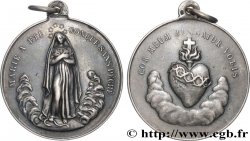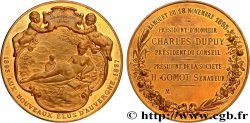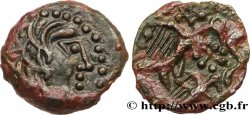fme_1048962 - DRITTE FRANZOSISCHE REPUBLIK Médaille PRO PATRIA - Préparation militaire
30.00 €
Menge
In den Warenkorb

Type : Médaille PRO PATRIA - Préparation militaire
Datum: 1911
Metall : Bronze
Durchmesser : 49,5 mm
Stempelstellung : 12 h.
Graveur GRANDHOMME Paul (1851-1944)
Gewicht : 68,97 g.
Rand Lisse + corne BRONZE
Punze : corne BRONZE
Kommentare zum Erhaltungszustand:
Jolie patine hétérogène avec la présence de marques d’oxydation et d’usure sur les reliefs. Le revers présente des traces d’écriture manuscrite
Vorderseite
Titulatur der Vorderseite SI. VIS. PACEM. PARA - BELLVM, (LÉGENDE CIRCULAIRE); À L’EXERGUE : PRO. PATRIA.
Beschreibung Vorderseite Jeune militaire à côté d’une personnification de la France, assise sur un canon, scène de bataille à l’arrière; signé : P. GRANDHOMME.
Rückseite
Titulatur der Rückseite ENTRAINEMENT. PHYSIQUE * PREPARATION. MILITAIRE, (LÉGENDE CIRCULAIRE); À L’EXERGUE : FORCE. COURAGE.
Beschreibung Rückseite Lion au pied d’une stèle : PRIX DU MINISTRE / DE LA / GUERRE; branches de lauriers, avion, fusil, gants, trompe et épées. Signé : P. GRANDHOMME 1911.
Kommentare
Médaille non attribuée.
Paul Victor Grandhomme, né en 1851 à Paris et mort en 1944 à Saint-Briac-sur-Mer, Ille-et-Vilaine, est un peintre émailleur, orfèvre et graveur médailleur français. Il eut pour maître Auguste Mollard (1836 - 1916), orfèvre et peintre sur émail. Il fut influencé par son ami le peintre Raphaël Collin. Il travailla avec Pierre Puvis de Chavannes (1824 - 1898), Jules-Élie Delaunay (1828 - 1891). En 1874 il présenta au Salon des artistes français un portrait émaillé Vittoria Colonna (1490 - 1547). En 1877, il eut pour élève Alfred Jean Garnier avec qui il s'associa et ils réalisèrent et signèrent des œuvres en commun. En 1890 au salon de la Société des artistes français ils présentèrent une Vierge d'après Carlo Crivelli ainsi qu'un portrait du roi Édouard VII du Royaume-Uni et en 1895 au Salon des artistes français, d'après Gustave Moreau : Hercule, Orphée, Jeunesse et immortalité, Léda, Sapho et Œdipe. Il est inhumé dans le cimetière de Saint-Briac-sur-Mer (Ille-et-Vilaine), son tombeau est surmonté d'une statuette de bronze réalisée par les sculpteurs Émile Armel-Beaufils (1882 - 1952) et son épouse Zannic Armel-Beaufils, née Suzanne Duvivier (1892-1978), sculpteuse.
Medal not awarded.
Paul Victor Grandhomme, born in 1851 in Paris and died in 1944 in Saint-Briac-sur-Mer, Ille-et-Vilaine, was a French enamel painter, goldsmith and medal engraver.. His master was Auguste Mollard (1836 - 1916), goldsmith and enamel painter.. He was influenced by his friend the painter Raphaël Collin. He worked with Pierre Puvis de Chavannes (1824 - 1898), Jules-Élie Delaunay (1828 - 1891). In 1874 he presented at the Salon des artistes français an enamelled portrait of Vittoria Colonna (1490 - 1547). In 1877, he had Alfred Jean Garnier as a student, with whom he joined forces and they produced and signed works together.. In 1890 at the Salon of the Society of French Artists they presented a Virgin after Carlo Crivelli as well as a portrait of King Edward VII of the United Kingdom and in 1895 at the Salon of French Artists, after Gustave Moreau: Hercules, Orpheus, Youth and Immortality, Leda, Sappho and Oedipus. He is buried in the cemetery of Saint-Briac-sur-Mer (Ille-et-Vilaine), his tomb is surmounted by a bronze statuette made by the sculptors Émile Armel-Beaufils (1882 - 1952) and his wife Zannic Armel-Beaufils, née Suzanne Duvivier (1892-1978), sculptor
Paul Victor Grandhomme, né en 1851 à Paris et mort en 1944 à Saint-Briac-sur-Mer, Ille-et-Vilaine, est un peintre émailleur, orfèvre et graveur médailleur français. Il eut pour maître Auguste Mollard (1836 - 1916), orfèvre et peintre sur émail. Il fut influencé par son ami le peintre Raphaël Collin. Il travailla avec Pierre Puvis de Chavannes (1824 - 1898), Jules-Élie Delaunay (1828 - 1891). En 1874 il présenta au Salon des artistes français un portrait émaillé Vittoria Colonna (1490 - 1547). En 1877, il eut pour élève Alfred Jean Garnier avec qui il s'associa et ils réalisèrent et signèrent des œuvres en commun. En 1890 au salon de la Société des artistes français ils présentèrent une Vierge d'après Carlo Crivelli ainsi qu'un portrait du roi Édouard VII du Royaume-Uni et en 1895 au Salon des artistes français, d'après Gustave Moreau : Hercule, Orphée, Jeunesse et immortalité, Léda, Sapho et Œdipe. Il est inhumé dans le cimetière de Saint-Briac-sur-Mer (Ille-et-Vilaine), son tombeau est surmonté d'une statuette de bronze réalisée par les sculpteurs Émile Armel-Beaufils (1882 - 1952) et son épouse Zannic Armel-Beaufils, née Suzanne Duvivier (1892-1978), sculpteuse.
Medal not awarded.
Paul Victor Grandhomme, born in 1851 in Paris and died in 1944 in Saint-Briac-sur-Mer, Ille-et-Vilaine, was a French enamel painter, goldsmith and medal engraver.. His master was Auguste Mollard (1836 - 1916), goldsmith and enamel painter.. He was influenced by his friend the painter Raphaël Collin. He worked with Pierre Puvis de Chavannes (1824 - 1898), Jules-Élie Delaunay (1828 - 1891). In 1874 he presented at the Salon des artistes français an enamelled portrait of Vittoria Colonna (1490 - 1547). In 1877, he had Alfred Jean Garnier as a student, with whom he joined forces and they produced and signed works together.. In 1890 at the Salon of the Society of French Artists they presented a Virgin after Carlo Crivelli as well as a portrait of King Edward VII of the United Kingdom and in 1895 at the Salon of French Artists, after Gustave Moreau: Hercules, Orpheus, Youth and Immortality, Leda, Sappho and Oedipus. He is buried in the cemetery of Saint-Briac-sur-Mer (Ille-et-Vilaine), his tomb is surmounted by a bronze statuette made by the sculptors Émile Armel-Beaufils (1882 - 1952) and his wife Zannic Armel-Beaufils, née Suzanne Duvivier (1892-1978), sculptor








 Berichten über einen Fehler
Berichten über einen Fehler Die Seite drucken
Die Seite drucken Teilen meiner Auswahl
Teilen meiner Auswahl Stellen Sie eine Frage
Stellen Sie eine Frage Einlieferung/Verkauf
Einlieferung/Verkauf
 Details
Details











